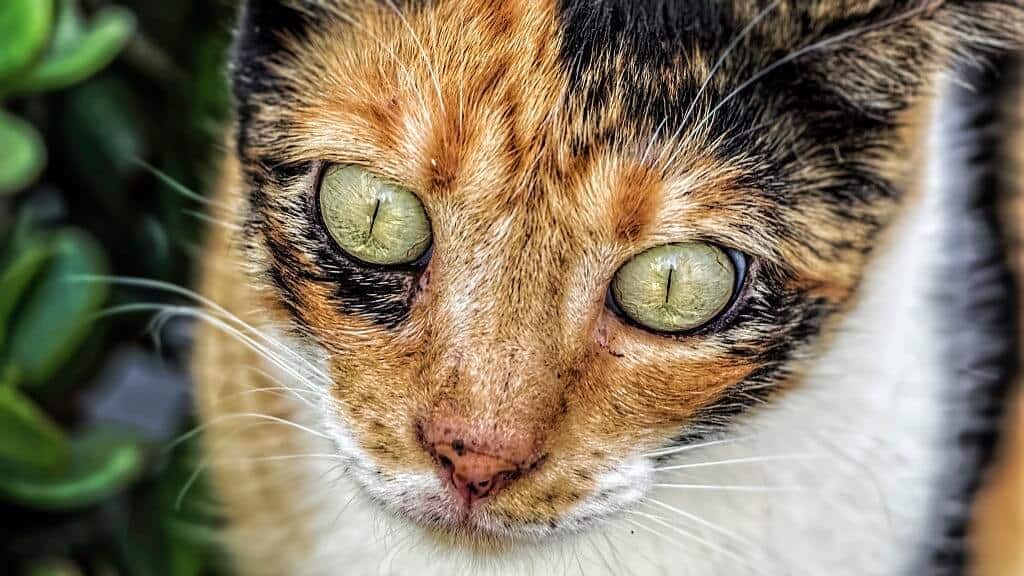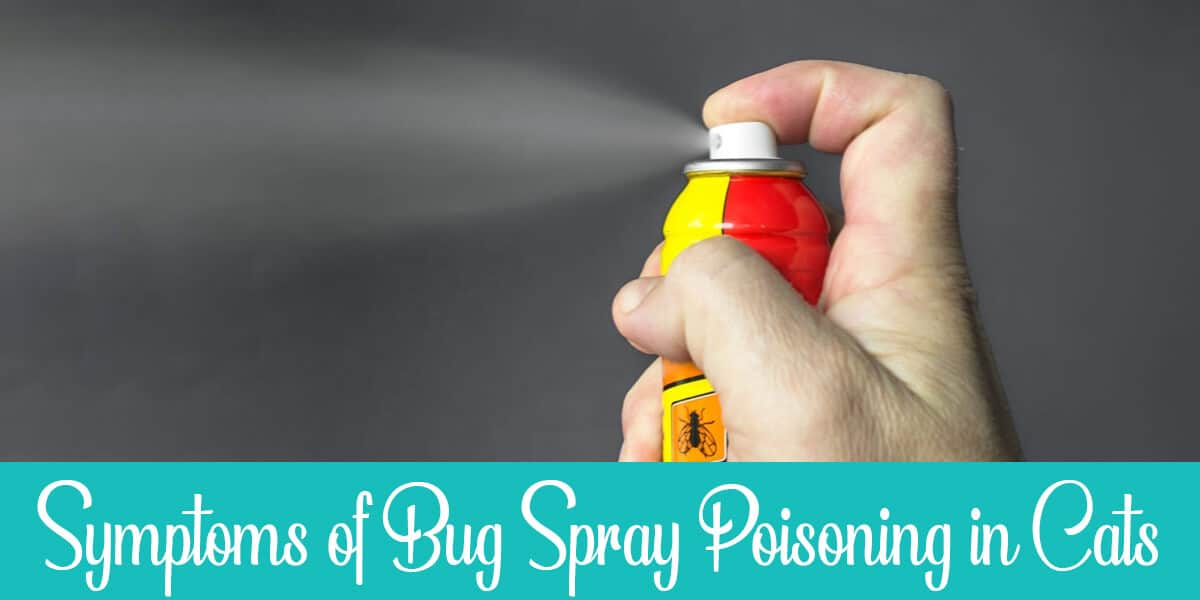People often forget that pets have a different metabolism than humans. Just because we can tolerate the occasional puff of bug spray doesn’t mean that cats can.
Bug sprays typically contain an organophosphorus compound or a pyrethrin derivative. Both interfere with nerve impulses on a synaptic level, causing serious damage.
In some cases, bug spray poisoning in cats can be lethal!
In this post, we shed light on the different symptoms of bug spray poisoning in cats you should look out for if you suspect your precious feline friend has been poisoned. We also address how you should go about managing insecticide poisoning in cats, so stick around.
Table of Contents
The Most Common Symptoms of Bug Spray Poisoning in Cats
The most common symptoms of bug spray poisoning in cats are gastrointestinal upsets, initial hyperexcitability, increased secretions, constricted pupils, tremors, hard breathing, and lack of coordination. Other accompanying symptoms include muscle weakness, eye tearing, drooling, vomiting, diarrhea, shaking, and abnormal urination.
1. Gastrointestinal Upset
Within a few minutes of ingesting organophosphorus compounds, felines start showing GIT disorders. It usually starts with vomiting and can escalate to extreme diarrhea.
Keep in mind that organophosphorus and pyrethroids don’t need to be ingested to be poisonous. Skin contact or inhalation might be enough to trigger symptoms in sensitive pets.
2. Initial Hyperexcitability
When we say “initial hyperexcitation,” it’s because the state lasts for a short while. It’s then followed by CNS depression. From here on, things are going to get a little complicated and might even seem a bit contradictory, so hang tight.
First, you must know how organophosphates work. They’re classified as acetylcholinesterase inhibitors. Acetylcholinesterase (AChE) is an enzyme that degrades acetylcholine (ACh).
ACh is a neurotransmitter that helps conduct nervous signals in the body. When ACh is done with its work, AChE breaks it down and recycles it to be used one more time.
When insecticides inhibit AChE, cats get hyper-excited, as there’s too much ACh going around! When this happens, your cat will become overactive and anxious, and its heart will beat rapidly. But this hyperexcitability doesn’t last long; ACh gets depleted soon enough.
3. Increased Secretions
Organophosphates also work by stimulating the parasympathetic nervous system. This means that you’ll see an excess of bodily secretion all over in the form of tears, saliva, nasal secretion, phlegm, and frequent urination.
4. Constricted Pupils

An overstimulated parasympathetic nervous system causes miosis and lacrimation. These appear as pupil constriction and increased tear flow.
Besides being uncomfortable, constricted pupils make matters worse for coordination when walking.
5. Lack of Coordination
Lack of coordination is a common sign of toxicity by pyrethroids and organophosphates. When a pet is exposed to AChE inhibitors, it’ll have difficulty walking. This is because insecticides impair the visual-spatial function in mammals.
Locomotor dysfunction is also common in human cases of organophosphate toxicity.
Visual-spatial processing is what allows us to intercept where things are relative to our bodies. It helps send signals like “Move your index finger to touch this; it’s only an inch away,” or “Lift your right leg to take a step on the stairs.”
Related Posts:
– How Do I Know if My Cat Has Lyme Disease?
– Is My Cat Suffering Rat Poisoning?
– 5 Signs of Nasal Polyps in Cats
– Signs of Mercury Poisoning in Cats
6. Tremors
By now, the initial stimulation starts to fade out. All that extra rush of acetylcholine is depleted. This time, though, no recycling takes place. Rather, the neurotransmitter reservoirs start to run critically low on ACh.
Since ACh is responsible for transmitting the nerve signals to the muscles, abnormal twitches can happen every time the cat tries to move a limb.
In extreme cases, the poisoned cat can start to experience full-body seizures.
7. Respiratory Failure

The most serious complication in cases of bug spray poisoning is respiratory distress.
Low acetylcholine levels affect the smooth respiratory muscles. This is a similar mechanism to the tremors in skeletal muscles.
Breathing gets harder and harder when there isn’t enough acetylcholine for muscle contraction.
Long Term Exposure to Organophosphorus
Chronic exposure to low-level insecticide containing organophosphate compounds can lead to:
- Flu-like symptoms. After a while, the increase in secretions starts to seem like regular flu. It can often get misdiagnosed as an allergic reaction or a viral infection.
- Peripheral polyneuropathy. In chronic cases, the tremors aren’t as severe as in acute cases. So, the skeletal muscles are exposed to subtle but frequent twitches. Over time, this can lead to permanent peripheral polyneuropathy.
- Cancer. Prolonged exposure to organophosphates has been associated with increased malignancy risk. According to the IARC, insecticides like parathion can be carcinogenic.
Managing Insecticide Poisoning in Cats
In the early stages, the best approach is to try to reduce the absorption immediately. If the bug spray was used directly on the cat’s skin, wash it thoroughly under running water.
If it was inhaled, get the pet into a place with good ventilation.
In ingestion cases, a vet can perform gastric lavage to empty the stomach. Activated charcoal is also an option for absorbing toxins.
In late cases, the insecticide has already been absorbed. At this point, any intervention is going to be pure symptomatic management in the form of:
- Intravenous hydration and electrolytes
- Anti-epileptics if the cat has seizures
- Oxygen therapy if the cat’s in respiratory distress
In severe cases, oxime compounds can be used as antidotes. They do a great job of separating the acetylcholine from the neurotoxin. This allows the former to carry out its function once again.
Summary
Bug sprays are a common household item; so common that we forget how dangerous they can be.
When left in the reach of children and pets, insecticides can be lethal. A slight difference in liver enzymes makes cats more susceptible to insecticide toxicity than humans.
The symptoms of bug spray poisoning in cats start slow and then escalate quickly. Once the poison gets to a critical stage, it can be hard to stabilize the poisoned animal. That’s why it’s always advisable to avoid any contact between pets and organophosphates.
Seek professional help immediately if you notice any signs of poisoning on your pet.

I’ve been living with cats since 2008 and I can confidently say I have more feline friends than humans lol. I currently live with 5 cats in different life stages; two of them are less than one year old, one is 2-ish years old and the oldest two are 9-ish years old. I’ve developed a strong bond with cats over the years and I’m eager to share my experience through this blog. You can learn more about my cats here.

